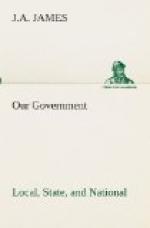The First Continental Congress, 1774.—When the coercive acts of 1774 had been passed, Massachusetts, now in greatest need, called for a congress of all the colonies. Delegates from all, Georgia[7] excepted, assembled at Philadelphia, September 5, 1774. In the Declaration of Rights, and in the adoption of the Articles of Association, they gave full expression to colonial sentiment. They commended the resistance of the people of Massachusetts. They declared that all “America ought to support them in their opposition,” if force should be used in carrying out the measures of Parliament.
[Footnote 7: Georgia was in sympathy with this movement.]
The Second Continental Congress, 1775.—Before adjourning, the First Continental Congress provided for the meeting of another congress, in May, 1775, unless the causes for colonial grievances should be earlier removed by the English government. But other measures of repression were quickly passed, and before the Second Continental Congress met, the battle of Lexington had been fought and the American forces were blockading Boston. This congress convened in Philadelphia May 10, 1775, and continued in session, with adjournments from time to time, until May 1, 1781. All of the colonies were represented. Like previous congresses, this was, at first, merely an advisory body, but necessity compelled it to act as a real government. It took control of military affairs, provided for a currency, threw open American ports to the ships of all nations, and did whatever else the necessities of the time seemed to demand. Having been appealed to for advice, this congress took a most notable position in recommending that new forms of government should be established in the several States. By the year 1777 ten States had framed new constitutions. It furthered independence by appointing a committee to draft resolutions based on the ideas of independence then everywhere present. The Declaration of Independence was the result.
The Articles of Confederation.—Franklin early saw the need for a more effective government than that of a revolutionary assembly. On July 21, 1775, he presented to Congress a plan for “perpetual union.” Nearly a year elapsed before a committee was appointed to prepare some form for confederation to be entered into between the colonies. Another period of a year and five months was to go by before the report of this committee was adopted by the Continental Congress. It was then submitted to the State legislatures for approval. After three years and a half, on March 1, 1781, Maryland, the last State, was induced to ratify the Articles of Confederation. The adoption of these articles is one of the most important events in the history of our nation. While the Articles of Confederation must always be regarded as a weak instrument of government, we must not forget that the Continental Congress was then working out problems in the province of government that were almost wholly new. The solution, faulty as it was, went far to establish the place of the written Constitution as a basis for government.




